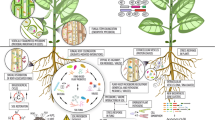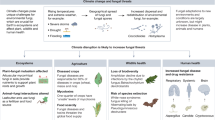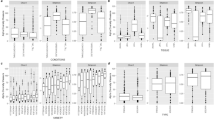Abstract
The mutualism between fungus-growing animals and fungi is a classic example of a complex interspecies association. A handful of insects, notably the well-recognized fungus-farming ants, termites and beetles, have developed advanced agriculture, which includes seeding new gardens with crop propagules, improving growth conditions and protecting and harvesting the fungal crop. More examples, which could be called ‘proto-fungiculture’, involve fewer adaptations, as exemplified by marine snails that farm intertidal fungi on marsh grass. Recent work has indicated that the solitary leaf-rolling weevil Euops chinensis (family Attelabidae) has a protofarming symbiosis with the mycangial fungus Penicillium herquei (family Trichocomaceae). In this study, we investigated how the weevils create cradles (leaf-rolls) for their offspring and protect the fungal garden. We describe new specialized structures and behaviors that E. chinensis females use for leaf-rolling and fungus inoculation. The fungus P. herquei produces the antibiotic (+)-scleroderolide in laboratory culture and in leaf-rolls, which can serve to inhibit microbial ‘weeds’ and pests, thus protecting the fungal garden against potential infection. The fungiculture of E. chinensis differs from other advanced insect fungiculture systems because female weevils do not continuously tend the inoculated microbe and do not depend nutritionally on the fungus. The defensive role of the cultivated fungus makes the attelabid weevils exceptional in ‘proto-fungiculture’ animals.
Similar content being viewed by others
Log in or create a free account to read this content
Gain free access to this article, as well as selected content from this journal and more on nature.com
or
References
Aanen DK, Eggleton P, Rouland-Lefevre C, Guldberg-Froslev T, Rosendahl S, Boomsma JJ . (2002). The evolution of fungus-growing termites and their mutualistic fungal symbionts. Proc Natl Acad Sci USA 99: 14887–14892.
Altschul SF, Madden TL, Schaffer AA, Zhang JH, Zhang Z, Miller W et al. (1997). Gapped BLAST and PSI-BLAST: a new generation of protein database search programs. Nucl Acids Res 25: 3389–3402.
Ayer WA, Hoyano Y, Pedras MS, Clardy J, Arnold E . (1987). Metabolites produced by the scleroderris canker fungus, Gremmeniella-Abietina. 2. The structure of scleroderolide. Can J Chem 65: 748–753.
Bianciotto V, Bandi C, Minerdi D, Sironi M, Tichy HV, Bonfante P . (1996). An obligately endosymbiotic mycorrhizal fungus itself harbors obligately intracellular bacteria. Appl Environ Microbiol 62: 3005–3010.
Biedermann PH, Taborsky M . (2011). Larval helpers and age polyethism in ambrosia beetles. Proc Natl Acad Sci USA 108: 17064–17069.
Currie CR, Stuart AE . (2001). Weeding and grooming of pathogens in agriculture by ants. Proc Biol Sci 268: 1033–1039.
Currie CR, Wong B, Stuart AE, Schultz TR, Rehner SA, Mueller UG et al. (2003a). Ancient tripartite coevolution in the attine ant-microbe symbiosis. Science 299: 386–388.
Currie CR, Scott JA, Summerbell RC, Malloch D . (2003b). Fungus-growing ants use antibiotic-producing bacteria to control garden parasites. Nature 423: 461.
Farrell BD, Sequeira AS, O’ Meara BC, Normark BB, Chung JH, Jordal BH . (2001). The evolution of agriculture in beetles (Curculionidae: Scolytinae and Platypodinae). Evolution 55: 2011–2027.
Hall TA . (1999). BioEdit: a user-friendly biological sequence alignment editor and analysis program for Windows 95/98/NT. Nucleic Acids Symp Ser 41: 95–98.
Hart AG, Anderson C, Ratnieks FL . (2002). Task partitioning in leafcutting ants. Acta Ethol 5: 1–11.
Heath JJ, Stireman JO . (2010). Dissecting the association between a gall midge, Asteromyia carbonifera, and its symbiotic fungus, Botryosphaeria dothidea. Entomol Exp Appl 137: 36–49.
Hsu SC, Lockwood JL . (1975). Powdered chitin agar as a selective medium for enumeration of actinomycetes in water and soil. Appl Microbiol 29: 422–426.
Kirk PM, Cannon PF, Minter DW, Stalpers JA . (2008) Dictionary of the Fungi 10th edn Cromwell Press: Trowbridge, UK.
Klaus HD, Walter G, Anderson TH . (2007) Compendium of Soil Fungi 2nd edn Academic Press.
Kobayashi C, Fukasawa Y, Hirose D, Kato M . (2008). Contribution of symbiotic mycangial fungi to larval nutrition of a leaf-rolling weevil. Evol Ecol 22: 711–722.
Kukor JJ, Martin MM . (1983). Acquisition of digestive enzymes by sicrid woodwasps from their fungal symbiont. Science 220: 1161–1163.
Little AE, Murakami T, Mueller UG, Currie CR . (2006). Defending against parasites: fungus-growing ants combine specialized behaviors and microbial symbionts to protect their fungus gardens. Biol Lett 2: 12–16.
Li XQ, Guo WF, Ding JQ . (2012). Mycangial fungus benefits the development of a leaf-rolling weevil Euops chinensis. J Insect Physiol 58: 867–873.
Mueller UG, Gerardo NM, Aanen DK, Six DL, Schultz TR . (2005). The evolution of agriculture in insects. Annu Rev Ecol Evol Syst 36: 563–595.
Mueller UG, Gerardo N . (2002). Fungus-farming insects: multiple origins and diverse evolutionary histories. Proc Natl Acad Sci USA 99: 15247–15249.
Nobre T, Rouland-Lefevre C, Aanen DK . (2011). Comparative biology of fungus cultivation in termites and ants. In: Bignell DE, Roisin Y, Lo N (eds). Biology of Termites: A Modern Synthesis. Springer: New York, NY, USA, pp 193–201.
Oh DC, Poulsen M, Currie CR, Clardy J . (2009). Dentigerumycin: a bacterial mediator of an ant-fungus symbiosis. Nat Chem Biol 5: 391–393.
Pazoutova S, Srutka P, Holusa J, Chudickova M, Kolarik M . (2010). Diversity of xylariaceous symbionts in Xiphydria wood wasps: role of vector and a host tree. Fungal Ecol 3: 392–401.
Poulsen M, Bot ANM, Nielsen MG, Boomsma JJ . (2002). Experimental evidence for the costs and hygienic significance of the antibiotic metapleural gland secretion in leaf-cutting ants. Behav Ecol Sociobiol 52: 151–157.
Poulsen M, Erhardt DP, Molinaro DJ, Lin TL, Currie CR . (2007). Antagonistic bacterial interactions help shape host-symbiont dynamics within the fungus-growing ant-microbe mutualism. PLoS One 2: e960.
Sakurai K . (1985). An attelabid weevil (Euops splendida) cultivates fungi. J Ethol 3: 151–156.
Schultz TR, Mueller UG, Currie CR, Rehner SA . (2004). A comparison of agriculture in humans and in fungus-growing ants. In: Fernando EV, Meredith B (eds). Insect-Fungal Associations: Ecology and Evolution. Oxford University Press: Oxford, USA, pp 149–190.
Sharma M, Schmid M, Rothballer M, Hause G, Zuccaro A, Imani J et al. (2008). Detection and identification of bacteria intimately associated with fungi of the order Sebacinales. Cell Microbiol 10: 2235–2246.
Silliman BR, Newell SY . (2003). Fungal farming in a snail. Proc Natl Acad Sci USA 100: 15643–15648.
Stach JEM, Maldonado LA, Ward AC, Goodfellow M, Bull AT . (2003). New primers for the class Actinobacteria: application to marine and terrestrial environments. Environ Microbiol 5: 828–841.
Toki W, Tanahashi M, Togashi K, Fukatsu T . (2012). Fungal farming in a non-social beetle. PLoS One 7: e41893.
Toki W, Takahashi Y, Togashi K . (2013). Fungal garden making inside bamboos by a non-social fungus-growing beetle. PloS One 8: e79515.
Wang Y, Mueller UG, Clardy J . (1999). Antifungal diketopiperazines from symbiotic fungus of fungus-growing ant Cyphomyrmex minutus. J Chem Ecol 25: 935–941.
Wang YZ, Wu K, Ding JQ . (2010). Host specificity of Euops chinensis, a potential biological control agent of Fallopia japonica, an invasive plant in Europe and North America. Biocontrol 55: 551–559.
White TJ, Bruns T, Lee S, Taylor JW . (1990) Amplification and Direct Sequencing of Fungal Ribosomal RNA Genes for Phylogenetics. Academic Press: New York, NY, USA.
Yuceer C, Hsu CY, Erbilgin N, Klepzig KD . (2011). Ultrastructure of the mycangium of the southern pine beetle, Dendroctonus frontalis (Coleoptera:Curculionidae, Scotylinae): complex morphology for complex interactions. Acta Zool 92: 216–224.
Acknowledgements
We thank Zhiqiang An at the University of Texas and Chengshu Wang at the Shanghai Institute for Life Science, Chinese Academy of Sciences for their valuable suggestions and comments on this study and Joan W Bennett at Rutgers University and John Taylor and Bruce Jaffee at the University of California for serving as presubmission reviewers. We gratefully acknowledge the financial support from the National Natural Science foundation of China (31270070) and the National Program of Drug Research and Development (2012ZX09301-003).
Author information
Authors and Affiliations
Corresponding authors
Ethics declarations
Competing interests
The authors declare no conflict of interest.
Additional information
Supplementary Information accompanies this paper on The ISME Journal website
Supplementary information
Rights and permissions
About this article
Cite this article
Wang, L., Feng, Y., Tian, J. et al. Farming of a defensive fungal mutualist by an attelabid weevil. ISME J 9, 1793–1801 (2015). https://doi.org/10.1038/ismej.2014.263
Received:
Revised:
Accepted:
Published:
Issue date:
DOI: https://doi.org/10.1038/ismej.2014.263
This article is cited by
-
The gut microbiota of insects: a potential source of bacteria and metabolites
International Journal of Tropical Insect Science (2024)
-
A review on nutritional and non-nutritional interactions of symbiotic and associated fungi with insect
Symbiosis (2023)
-
Bacterial ectosymbionts in cuticular organs chemically protect a beetle during molting stages
The ISME Journal (2022)
-
Insect gut bacteria: a promising tool for enhanced biogas production
Reviews in Environmental Science and Bio/Technology (2022)
-
Antimicrobial activity and carbohydrate metabolism in the bacterial metagenome of the soil-living invertebrate Folsomia candida
Scientific Reports (2019)



